Response of 4H-SiC Detectors to Ionizing Particles
Abstract
1. Introduction
2. Materials and Methods
3. Results
3.1. Electrical Characterization of SiC Detectors
3.2. Response of 4H-SiC Detectors to Alpha Particles
3.3. Response of 4H-SiC Detectors to Gamma Radiation
4. Discussion
Supplementary Materials
Author Contributions
Funding
Data Availability Statement
Acknowledgments
Conflicts of Interest
References
- Liu, L.Y.; Wang, L.; Jin, P.; Liu, J.L.; Zhang, X.P.; Chen, L.; Zhang, J.F.; Ouyang, X.P.; Liu, A.; Huang, R.H.; et al. The fabrication and characterization of Ni/4H-SiC schottky diode radiation detectors with a sensitive area of up to 4 cm2. Sensors 2017, 17, 2334. [Google Scholar] [CrossRef] [PubMed]
- Hedayati, R.; Lanni, L.; Rodriguez, S.; Malm, B.G.; Rusu, A.; Zetterling, C.M. A monolithic, 500 °C operational amplifier in 4H-SiC bipolar technology. IEEE Electron Device Lett. 2014, 35, 693–695. [Google Scholar] [CrossRef]
- Knoll, G.F. Radiation Detection and Measurement, 4th ed.; Wiley: Hoboken, NJ, USA, 2010. [Google Scholar]
- Nava, F.; Bertuccio, G.; Cavallini, A.; Vittone, E. Silicon carbide and its use as a radiation detector material. Meas. Sci. Technol. 2008, 19, 102001. [Google Scholar] [CrossRef]
- Sellin, P.J.; Vaitkus, J. New materials for radiation hard semiconductor dectectors. Nucl. Instrum. Methods Phys. Res. Sect. A Accel. Spectrometers Detect. Assoc. Equip. 2006, 557, 479–489. [Google Scholar] [CrossRef]
- Tudisco, S.; La Via, F.; Agodi, C.; Altana, C.; Borghi, G.; Boscardin, M.; Bussolino, G.; Calcagno, L.; Camarda, M.; Cappuzzello, F.; et al. Sicilia—silicon carbide detectors for intense luminosity investigations and applications. Sensors 2018, 18, 2289. [Google Scholar] [CrossRef] [PubMed]
- Morales-Chávez, J.; Herrera-Celis, J.; Saldana-Ahuactzi, Z.; Reyes-Betanzo, C.; Gómez-Montaño, F.J.; Orduña-Díaz, A. Silicon and hydrogenated amorphous silicon carbide as biofunctional platforms for immunosensors. Surf. Interfaces 2020, 20, 100550. [Google Scholar] [CrossRef]
- Naderi, N.; Moghaddam, M. Ultra-sensitive UV sensors based on porous silicon carbide thin films on silicon substrate. Ceram. Int. 2020, 46, 13821–13826. [Google Scholar] [CrossRef]
- Verdon, C.; Szwedek, O.; Allemand, A.; Jacques, S.; Le Petitcorps, Y.; David, P. High temperature oxidation of two- and three-dimensional hafnium carbide and silicon carbide coatings. J. Eur. Ceram. Soc. 2014, 34, 879–887. [Google Scholar] [CrossRef]
- Nava, F.; Vanni, P.; Bruzzi, M.; Lagomarsino, S.; Sciortino, S.; Wagner, G.; Lanzieri, C. Minimum ionizing and alpha particles detectors based on epitaxial semiconductor silicon carbide. IEEE Trans. Nucl. Sci. 2004, 51, 238–244. [Google Scholar] [CrossRef]
- Ruddy, F.H.; Seidel, J.G.; Chen, H.; Dulloo, A.R.; Ryu, S.H. High-resolution alpha-particle spectrometry using 4H silicon carbide semiconductor detectors. IEEE Trans. Nucl. Sci. 2006, 53, 1713–1718. [Google Scholar] [CrossRef]
- Radulović, V.; Yamazaki, Y.; Pastuović, Ž.; Sarbutt, A.; Ambrožič, K.; Bernat, R.; Ereš, Z.; Coutinho, J.; Ohshima, T.; Capan, I.; et al. Silicon carbide neutron detector testing at the JSI TRIGA reactor for enhanced border and port security. Nucl. Instruments Methods Phys. Res. Sect. A Accel. Spectrometers Detect. Assoc. Equip. 2020, 972, 164122. [Google Scholar] [CrossRef]
- Hodgson, M.; Lohstroh, A.; Sellin, P.; Thomas, D. Characterization of silicon carbide and diamond detectors for neutron applications. Meas. Sci. Technol. 2017, 28, 105501. [Google Scholar] [CrossRef]
- Pini, S.; Bruzzi, M.; Bucciolini, M.; Borchi, E.; Lagomarsino, S.; Menichelli, D.; Miglio, S.; Nava, F.; Sciortino, S. High-bandgap semiconductor dosimeters for radiotherapy applications. Nucl. Instrum. Methods Phys. Res. Sect. A Accel. Spectrom. Detect. Assoc. Equip. 2003, 514, 135–140. [Google Scholar] [CrossRef]
- Moscatelli, F. Silicon carbide for UV, alpha, beta and X-ray detectors: Results and perspectives. Nucl. Instrum. Methods Phys. Res. Sect. A Accel. Spectrom. Detect. Assoc. Equip. 2007, 583, 157–161. [Google Scholar] [CrossRef]
- Palestini, C. Advanced Technologies for Security Applications; Springer: Dordrecht, The Netherlands, 2019; ISBN 9789402420234. [Google Scholar]
- Mandal, K.C.; Kleppinger, J.W.; Chaudhuri, S.K. Advances in high-resolution radiation detection using 4h-sic epitaxial layer devices. Micromachines 2020, 11, 254. [Google Scholar] [CrossRef]
- Ruddy, F.H.; Dulloo, A.R.; Seidel, J.G.; Palmour, J.W.; Singh, R. The charged particle response of silicon carbide semiconductor radiation detectors. Nucl. Instrum. Methods Phys. Res. Sect. A Accel. Spectrom. Detect. Assoc. Equip. 2003, 505, 159–162. [Google Scholar] [CrossRef]
- Ivanov, A.M.; Kalinina, E.V.; Kholuyanov, G.; Strokan, N.B.; Onushkin, G.; Konstantinov, A.O.; Hallén, A.; Kuznetsov, A.Y. High Energy Resolution Detectors Based on 4H-SiC. Mater. Sci. Forum 2005, 483–485, 1029–1032. [Google Scholar] [CrossRef]
- Coutinho, J.; Torres, V.J.B.; Capan, I.; Brodar, T.; Ereš, Z.; Bernat, R.; Radulović, V. Silicon carbide diodes for neutron detection. Nucl. Inst. Methods Phys. Res. A 2020, 986, 164793. [Google Scholar] [CrossRef]
- Flammang, R.W.; Seidel, J.G.; Ruddy, F.H. Fast neutron detection with silicon carbide semiconductor radiation detectors. Nucl. Instrum. Methods Phys. Res. Sect. A Accel. Spectrom. Detect. Assoc. Equip. 2007, 579, 177–179. [Google Scholar] [CrossRef]
- Lioliou, G.; Chan, H.K.; Gohil, T.; Vassilevski, K.V.; Wright, N.G.; Horsfall, A.B.; Barnett, A.M. 4H-SiC Schottky diode arrays for X-ray detection. Nucl. Instrum. Methods Phys. Res. Sect. A Accel. Spectrom. Detect. Assoc. Equip. 2016, 840, 145–152. [Google Scholar] [CrossRef]
- Ito, M.; Storasta, L.; Tsuchida, H. Development of 4H-SiC epitaxial growth technique achieving high growth rate and large-area uniformity. Appl. Phys. Express 2008, 1, 2–5. [Google Scholar] [CrossRef]
- Lang, D.V. Deep-level transient spectroscopy: A new method to characterize traps in semiconductors. J. Appl. Phys. 1974, 45, 3023–3032. [Google Scholar] [CrossRef]
- Peaker, A.R.; Markevich, V.P.; Coutinho, J. Junction spectroscopy techniques and deep-level defects in semiconductors. J. Appl. Phys. 2018, 123, 161559. [Google Scholar] [CrossRef]
- Son, N.T.; Trinh, X.T.; Løvlie, L.S.; Svensson, B.G.; Kawahara, K.; Suda, J.; Kimoto, T.; Umeda, T.; Isoya, J.; Makino, T.; et al. Negative-U system of carbon vacancy in 4H-SiC. Phys. Rev. Lett. 2012, 109, 23–27. [Google Scholar] [CrossRef] [PubMed]
- Capan, I.; Brodar, T.; Pastuović, Z.; Siegele, R.; Ohshima, T.; Sato, S.I.; Makino, T.; Snoj, L.; Radulović, V.; Coutinho, J.; et al. Double negatively charged carbon vacancy at the h- and k-sites in 4H-SiC: Combined Laplace-DLTS and DFT study. J. Appl. Phys. 2018, 123, 161597. [Google Scholar] [CrossRef]
- Capan, I.; Brodar, T.; Coutinho, J.; Ohshima, T.; Markevich, V.P.; Peaker, A.R. Acceptor levels of the carbon vacancy in 4H-SiC: Combining Laplace deep level transient spectroscopy with density functional modeling. J. Appl. Phys. 2018, 124, 245701. [Google Scholar] [CrossRef]
- Booker, I.D.; Hassan, J.U.; Lilja, L.; Beyer, F.C.; Karhu, R.; Bergman, J.P.; Danielsson, Ö.; Kordina, O.; Sveinbjörnsson, E.Ö.; Janzén, E. Carrier lifetime controlling defects Z1/2 and RB1 in standard and chlorinated chemistry grown 4H-SiC. Cryst. Growth Des. 2014, 14, 4104–4110. [Google Scholar] [CrossRef]
- Delacroix, D.; Guerre, J.P.; Leblanc, P.; Hickman, C.; Penney, B.C. Radionuclide and Radiation Protection Data Handbook. Med. Phys. 2003, 30, 277. [Google Scholar] [CrossRef]
- Jarrell, J.; Stika, M.; Chaiken, M.; Simpson, M.; Blue, T.E.; Cao, L.R. Determination of the thickness of an electrodeposited thorium film with SiC alpha detectors. J. Radioanal. Nucl. Chem. 2017, 311, 1127–1133. [Google Scholar] [CrossRef]
- Ziegler, J.F.; Ziegler, M.D.; Biersack, J.P. SRIM-The stopping and range of ions in matter. Nucl. Instrum. Methods Phys. Res. Sect. B Beam Interact. Mater. Atoms 2010, 268, 1818–1823. [Google Scholar] [CrossRef]
- Ziegler, J.F.; Biersack, J.P. The Stopping and Range of Ions in Matter. In Treatise Heavy-Ion Science; Springer: Boston, MA, USA, 1985; pp. 93–129. [Google Scholar]
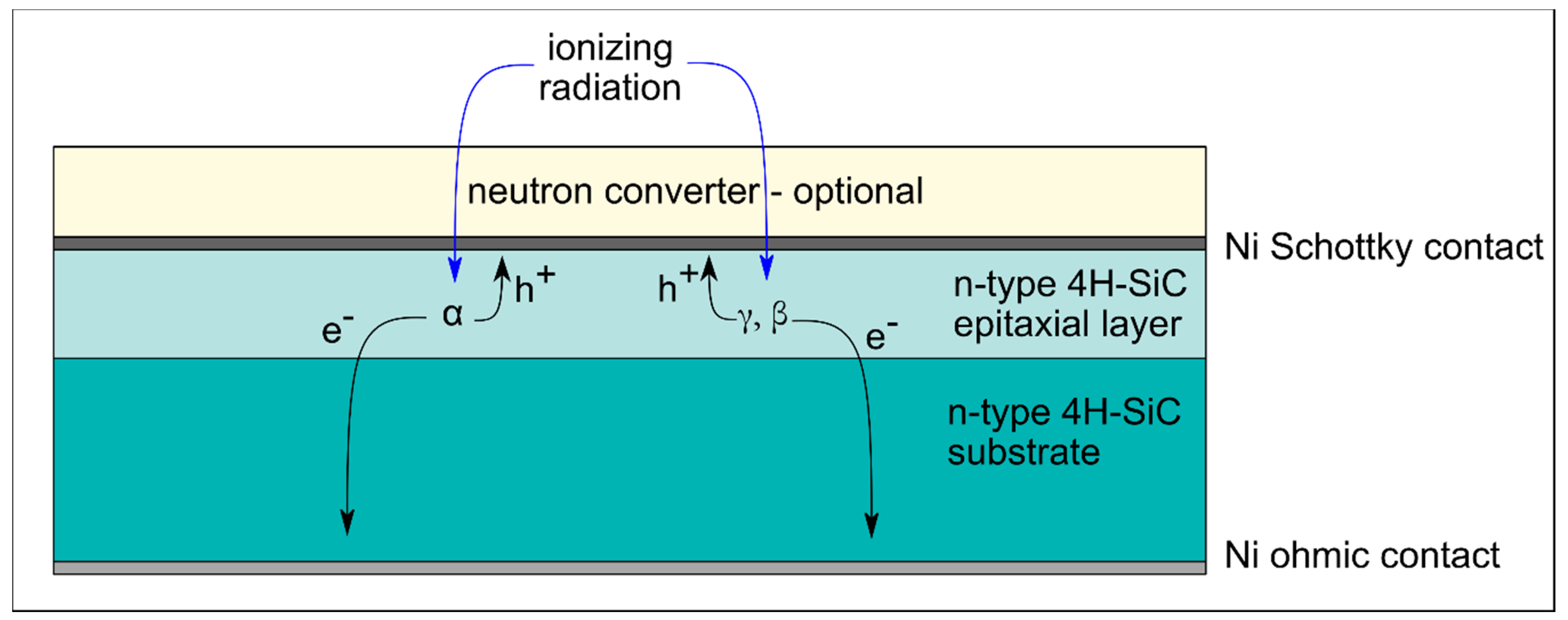
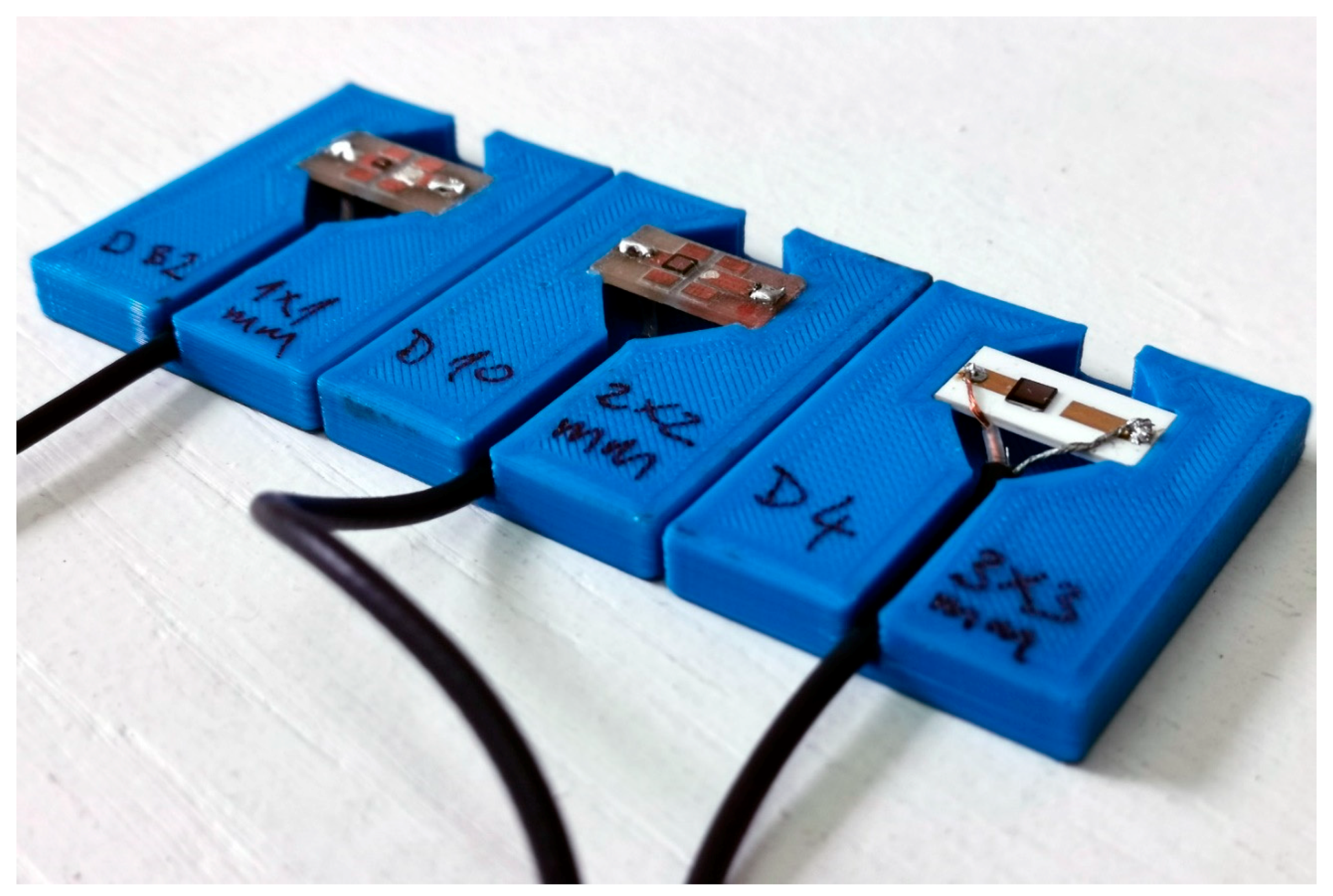
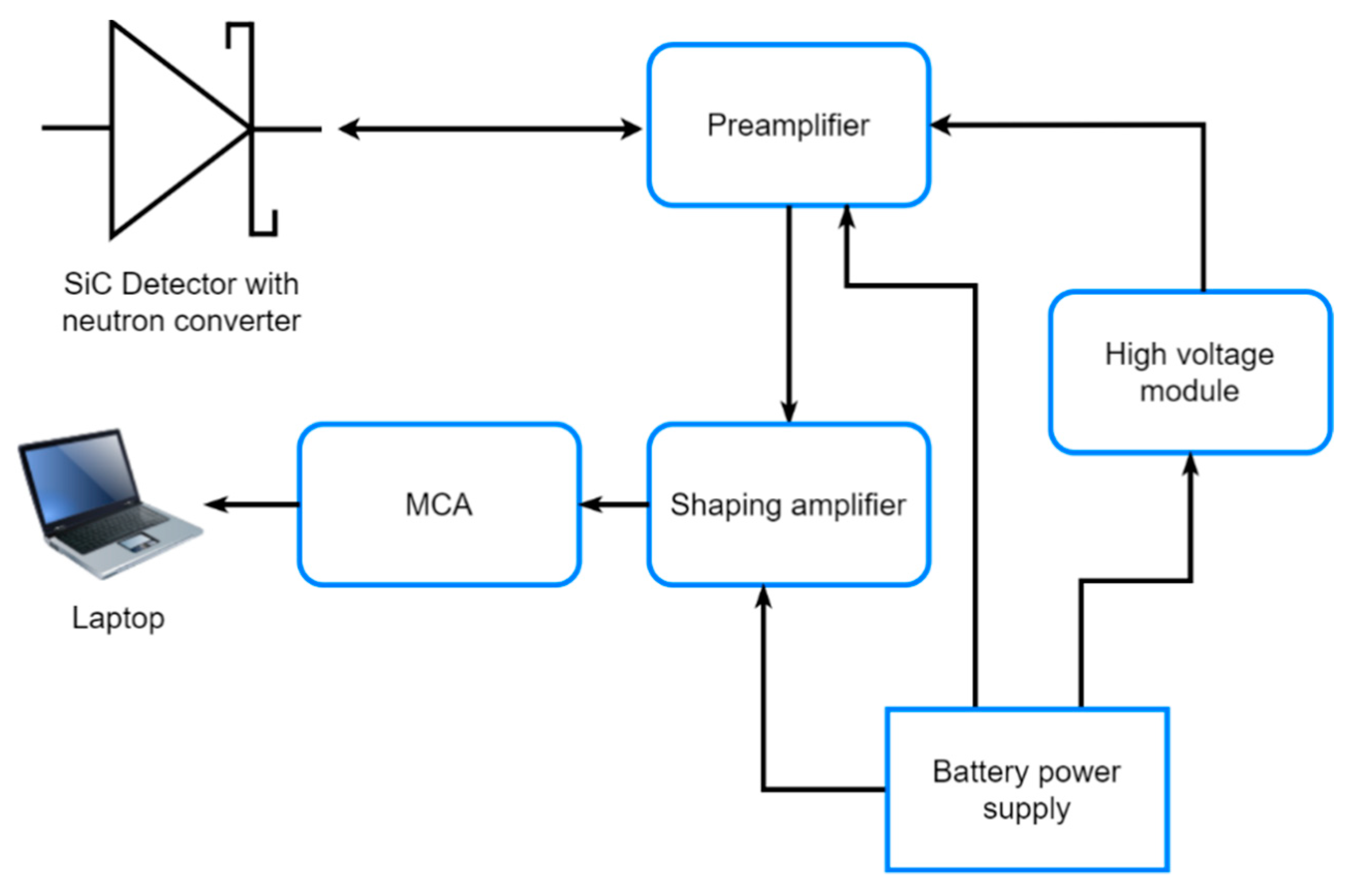
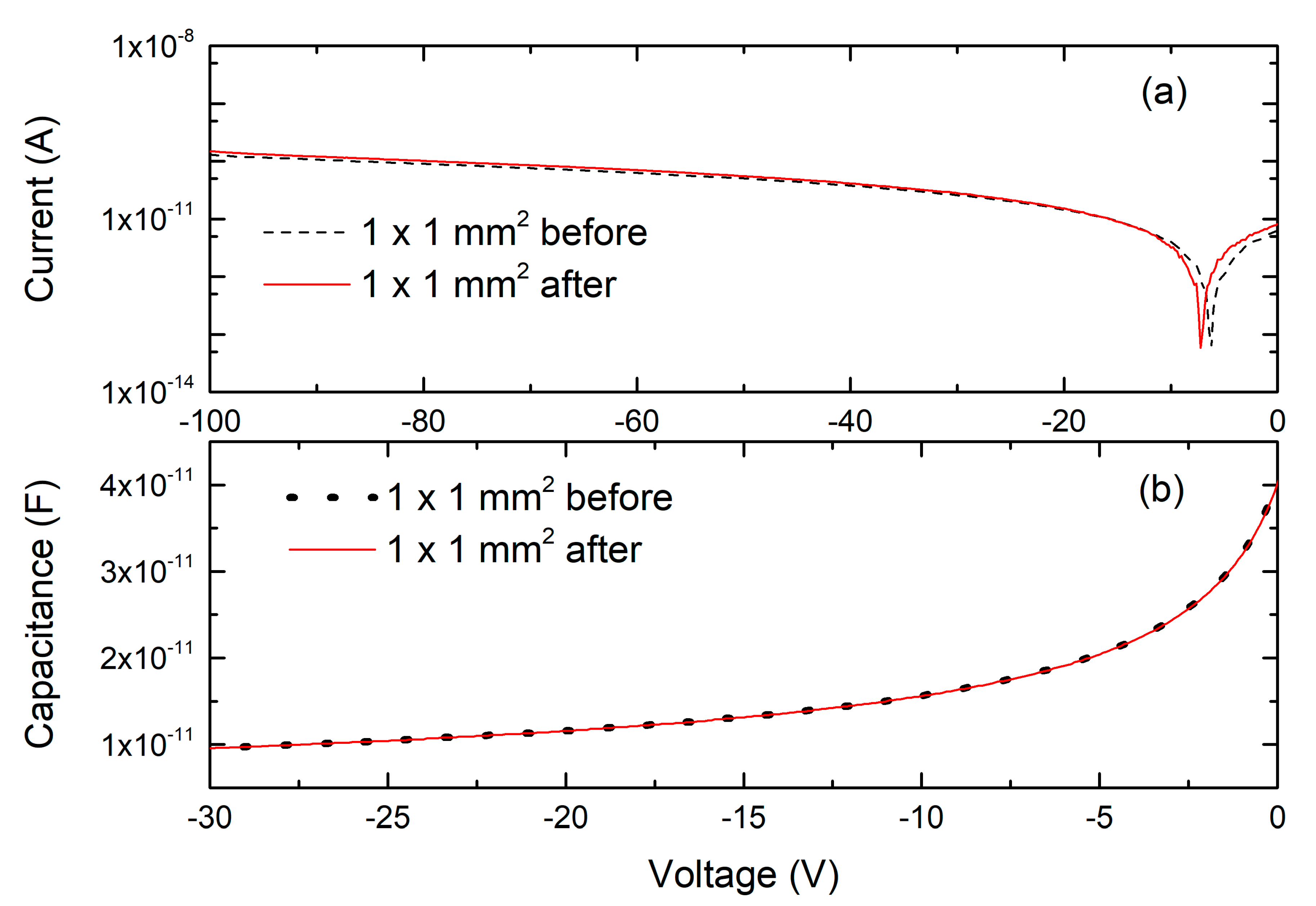
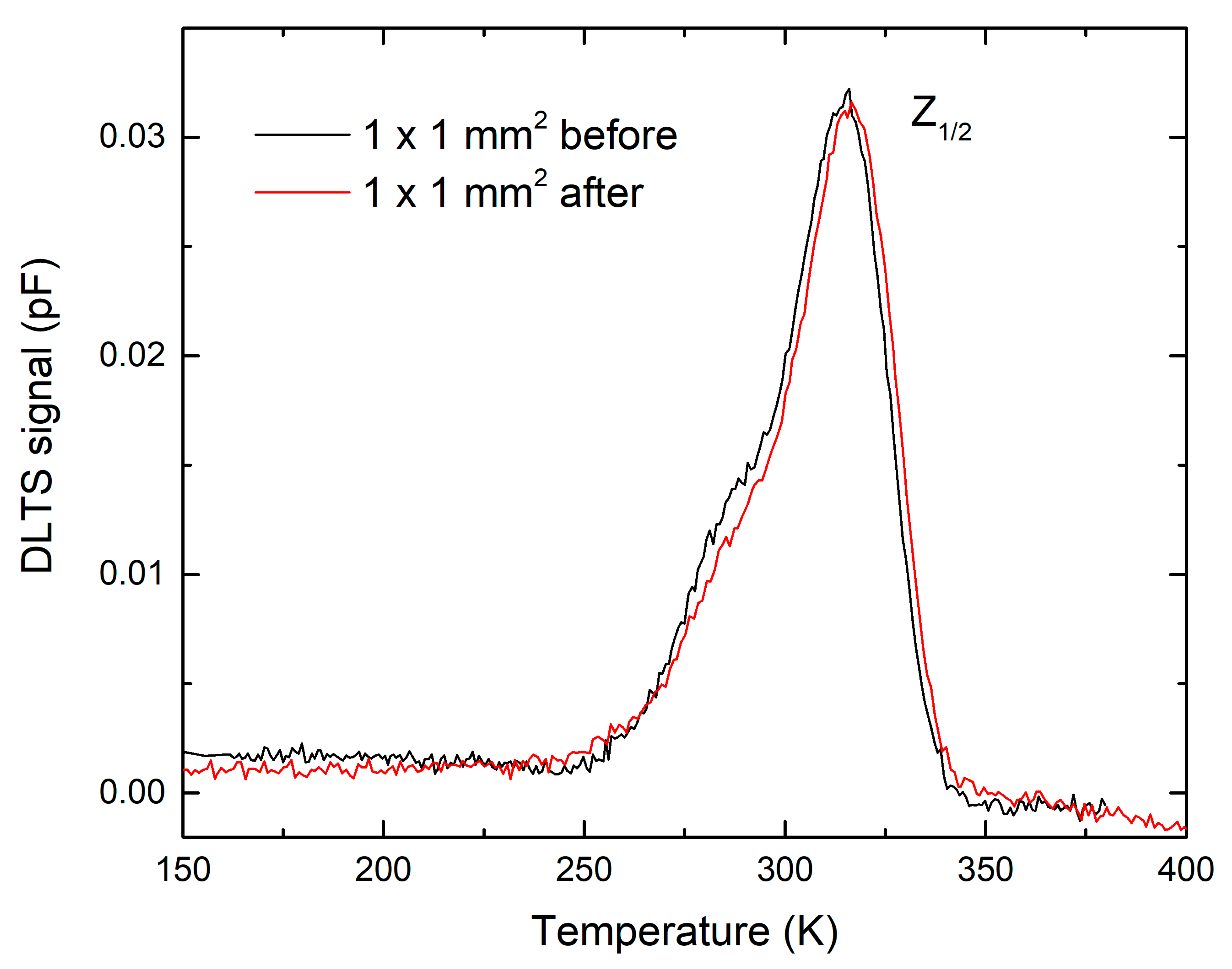
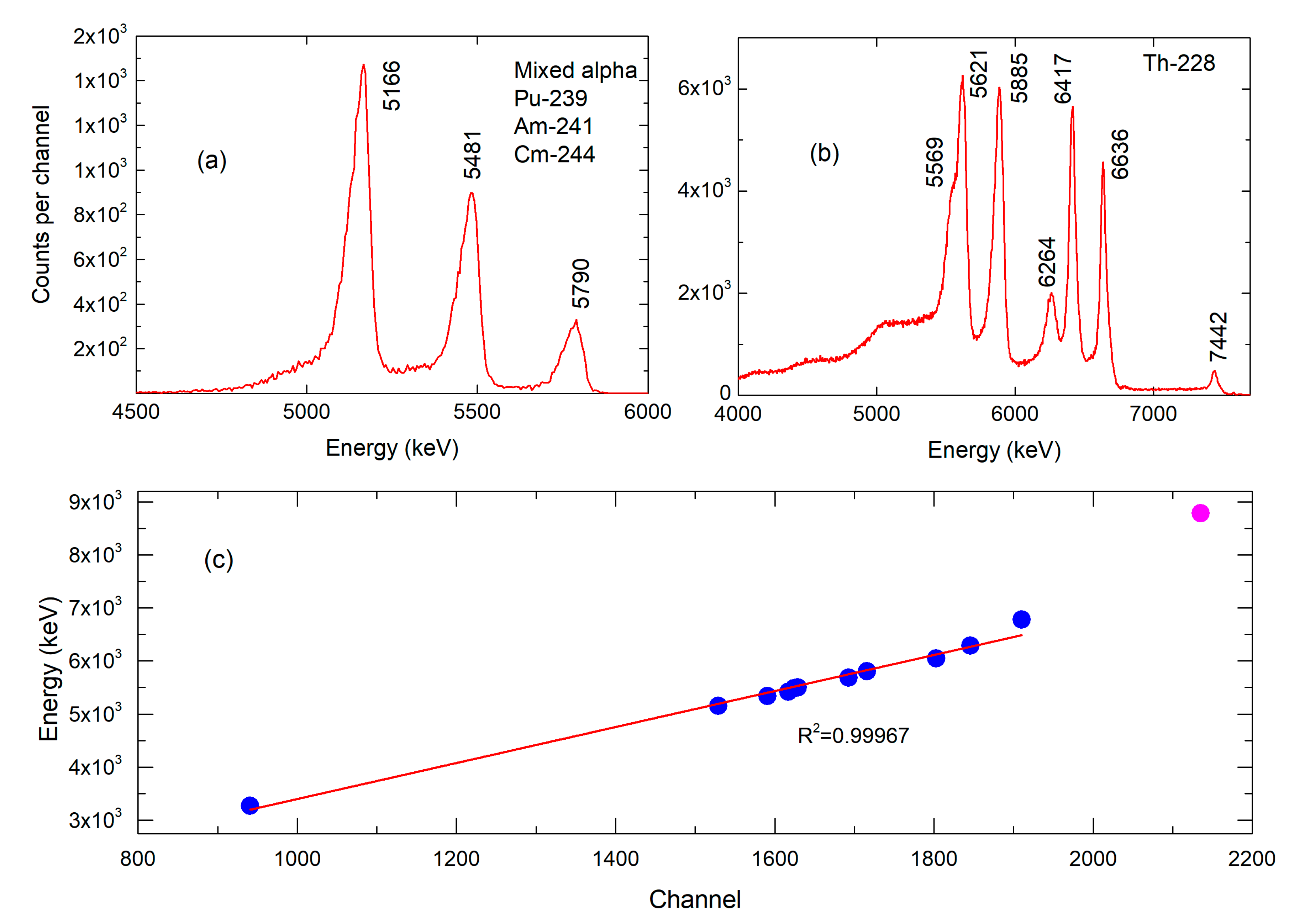
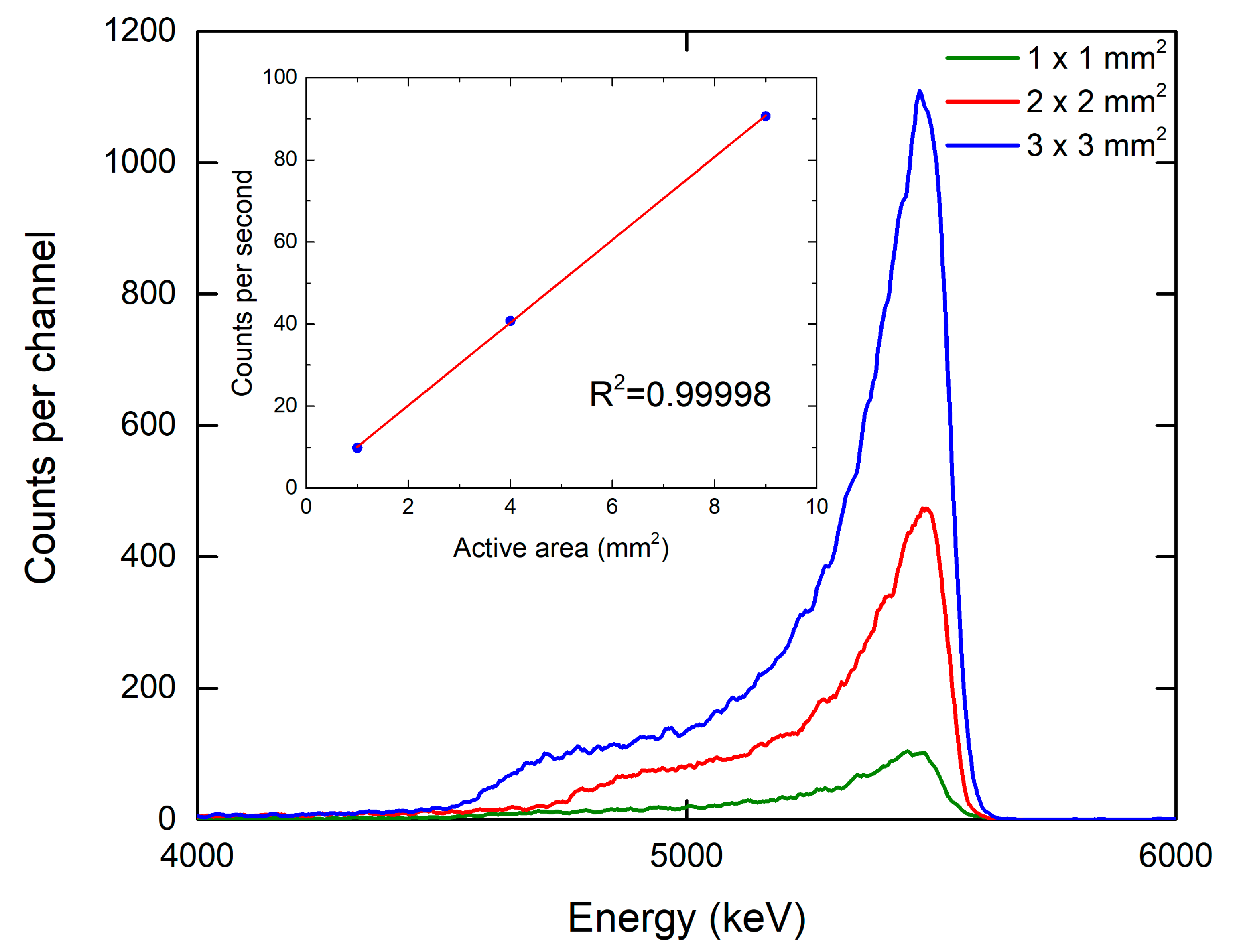
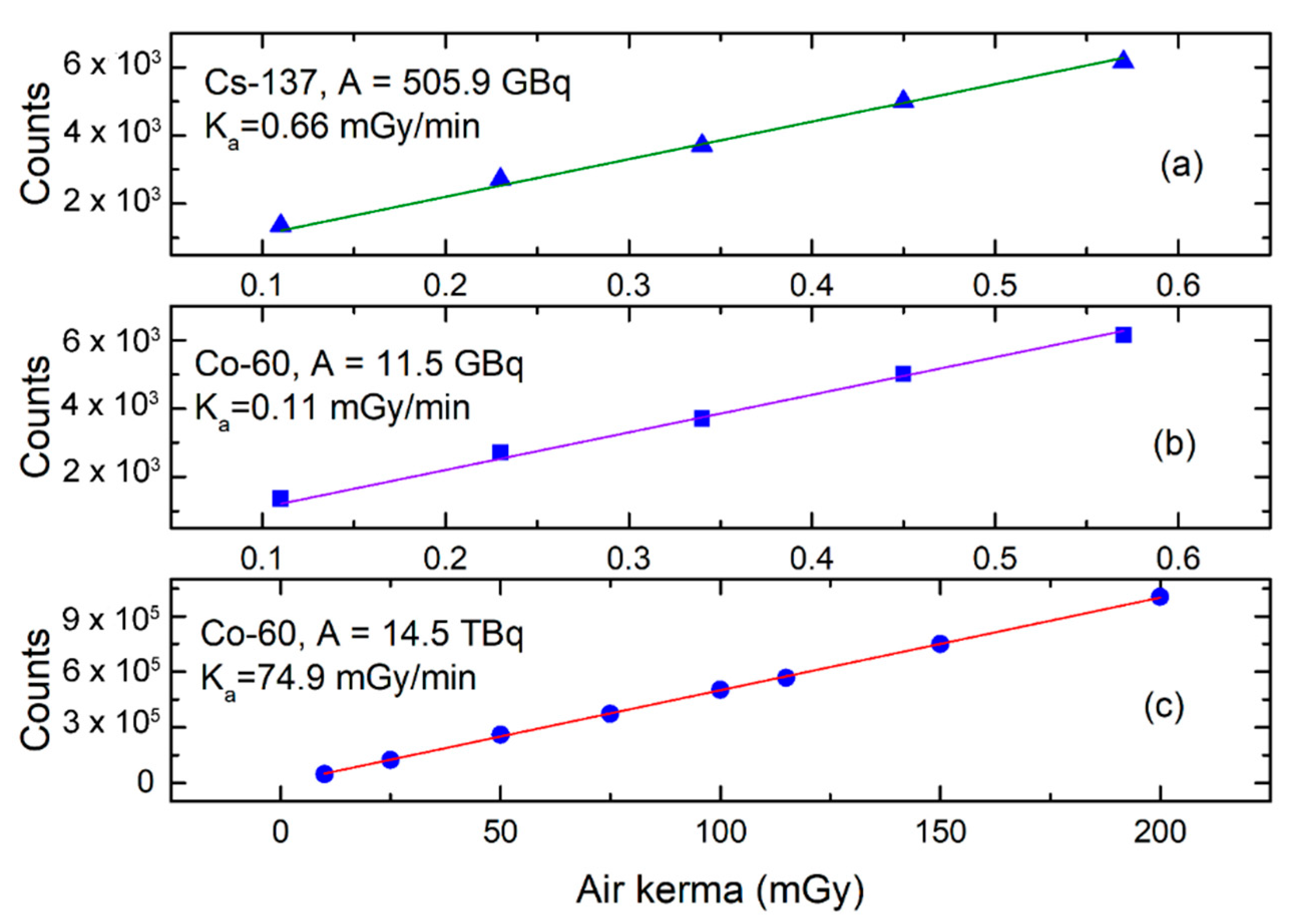
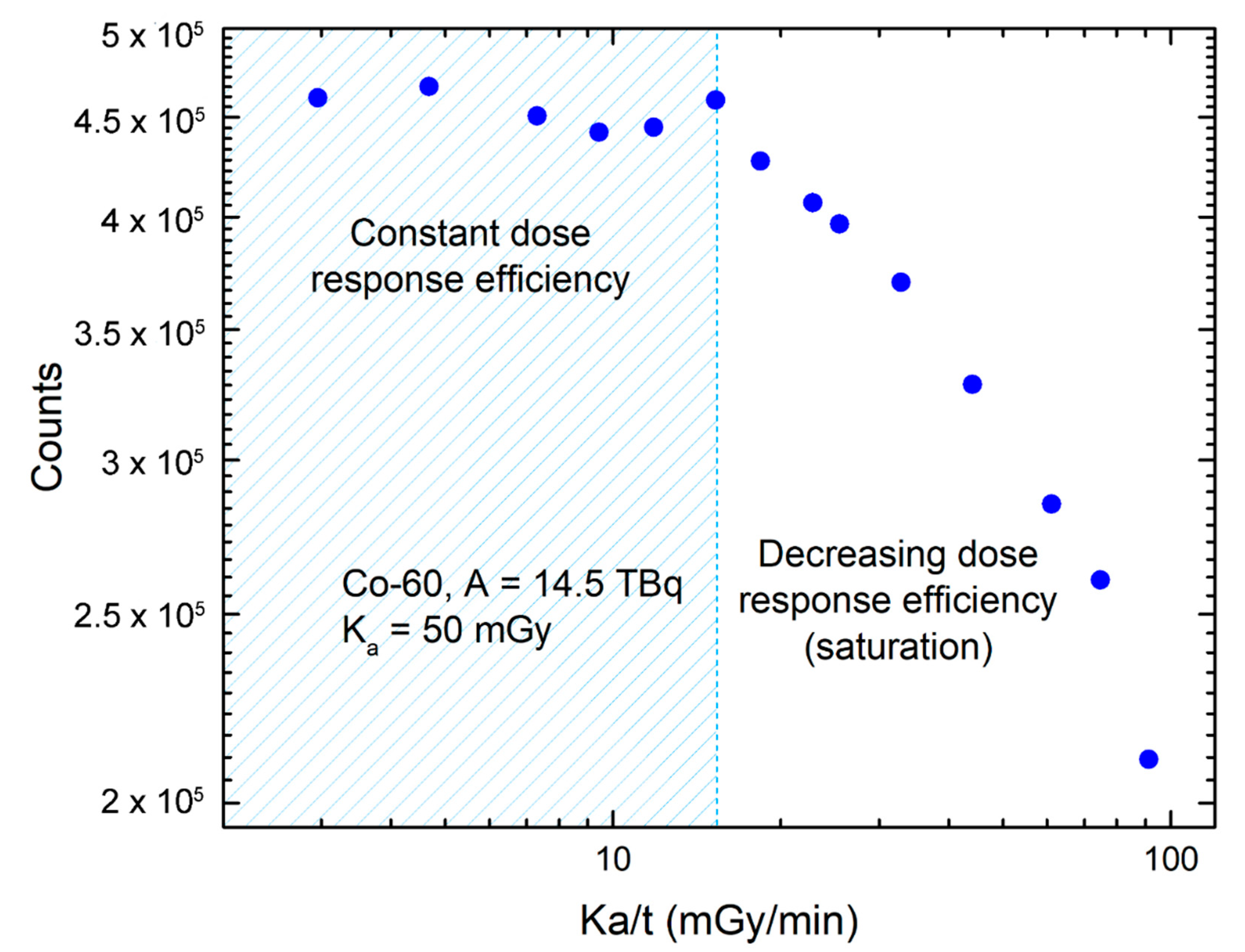
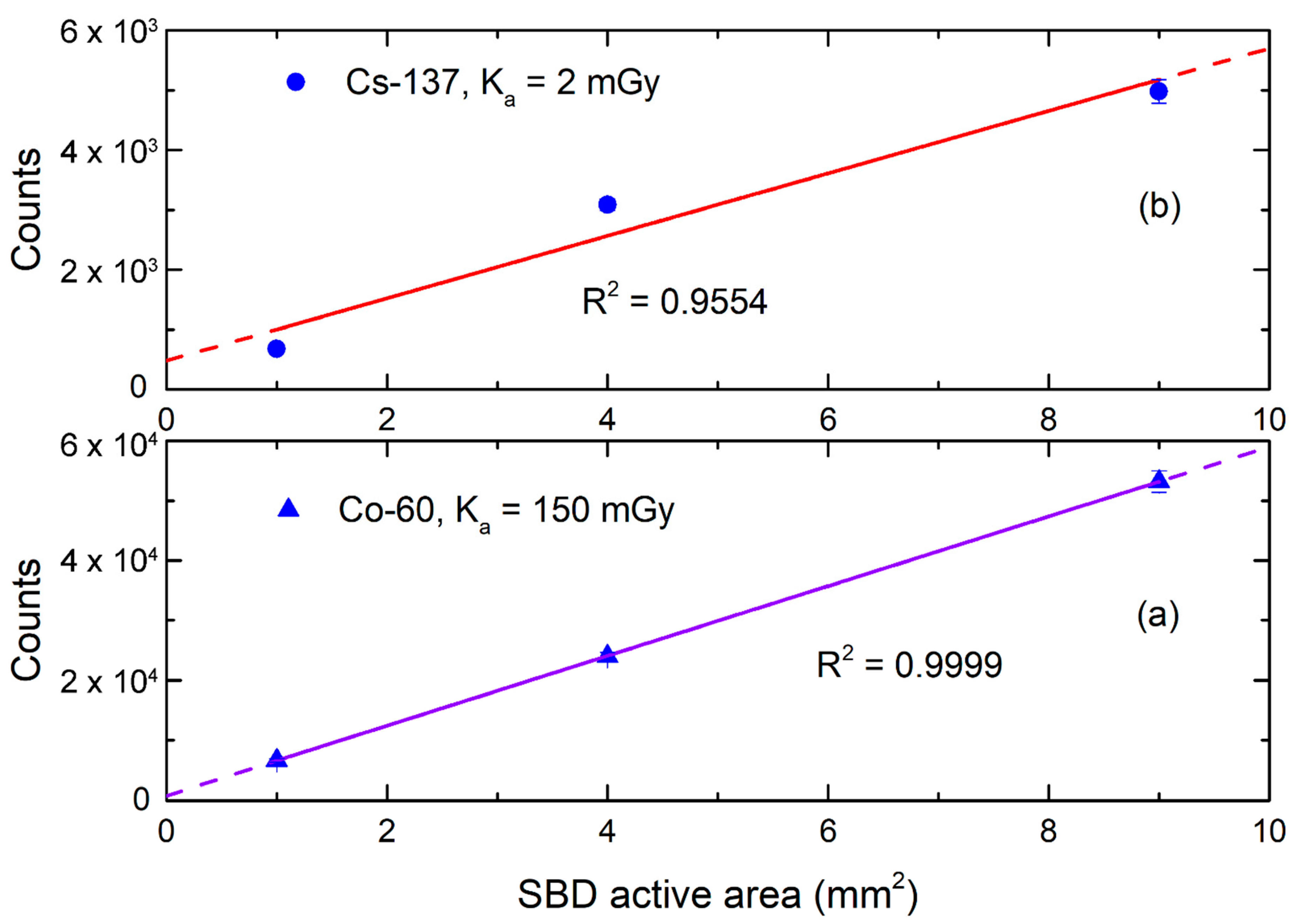
| Sample | Ideality Factor | Schottky Barrier Height (eV) | Series Resistance (Ω) | Free Carrier Concentration (cm−3) | |
|---|---|---|---|---|---|
| 1 × 1 mm2 | Before | 1.010 | 1.61 | 45 | 4.4 × 1014 |
| After | 1.015 | 1.58 | 48 | 4.4 × 1014 | |
| 2 × 2 mm2 | Before | 1.003 | 1.64 | 35 | 4.0 × 1014 |
| After | 1.080 | 1.55 | 65 | 4.2 × 1014 | |
| 3 × 3 mm2 | Before | 1.017 | 1.60 | 28 | 4.7 × 1014 |
| After | 1.027 | 1.55 | 28 | 4.7 × 1014 | |
| Sample | ||
|---|---|---|
| 1 × 1 mm2 | 0.68 ± 0.01 | 9 × 10−15 |
| 2 × 2 mm2 | 0.69 ± 0.01 | 1 × 10−14 |
| 3 × 3 mm2 | 0.67 ± 0.01 | 6 × 10−15 |
| Radionuclide | α Emmision Energy/ies with Yield, (keV) | β Emmision Energy/ies with Yield, (keV) | γ Emmision Energy/ies with Yyield, (keV) |
|---|---|---|---|
| Co-60 | - | 318 (100%), 1491 (<1%) | 1173 (100%), 1333 (100%) |
| Cs-137 | - | 512 (95%), 1173 (5%) | 662 (85%), 32 (6%) |
| Gd-148 | 3183 (100%) | - | - |
| Th-228 1 | 5340, 5423, 5685, 6050, 6288, 6778 and 8784 | - | 84 (1%) |
| Pu-238 | 5499 (71%), 5459 (29%) | - | 16 (12%) |
| Pu-239 | 5156 (73%), 5143 (15%), 5105 (12%) | - | 16 (6%) |
| Am-241 | 5486 (1%), 5443 (13%), 5388 (85%) | - | 60 (36%), 18 (18%), 14 (13%) |
| Cm-244 | 5805 (76%), 5763 (24%), | - | 17 (11%) |
Publisher’s Note: MDPI stays neutral with regard to jurisdictional claims in published maps and institutional affiliations. |
© 2020 by the authors. Licensee MDPI, Basel, Switzerland. This article is an open access article distributed under the terms and conditions of the Creative Commons Attribution (CC BY) license (http://creativecommons.org/licenses/by/4.0/).
Share and Cite
Bernat, R.; Capan, I.; Bakrač, L.; Brodar, T.; Makino, T.; Ohshima, T.; Pastuović, Ž.; Sarbutt, A. Response of 4H-SiC Detectors to Ionizing Particles. Crystals 2021, 11, 10. https://doi.org/10.3390/cryst11010010
Bernat R, Capan I, Bakrač L, Brodar T, Makino T, Ohshima T, Pastuović Ž, Sarbutt A. Response of 4H-SiC Detectors to Ionizing Particles. Crystals. 2021; 11(1):10. https://doi.org/10.3390/cryst11010010
Chicago/Turabian StyleBernat, Robert, Ivana Capan, Luka Bakrač, Tomislav Brodar, Takahiro Makino, Takeshi Ohshima, Željko Pastuović, and Adam Sarbutt. 2021. "Response of 4H-SiC Detectors to Ionizing Particles" Crystals 11, no. 1: 10. https://doi.org/10.3390/cryst11010010
APA StyleBernat, R., Capan, I., Bakrač, L., Brodar, T., Makino, T., Ohshima, T., Pastuović, Ž., & Sarbutt, A. (2021). Response of 4H-SiC Detectors to Ionizing Particles. Crystals, 11(1), 10. https://doi.org/10.3390/cryst11010010








